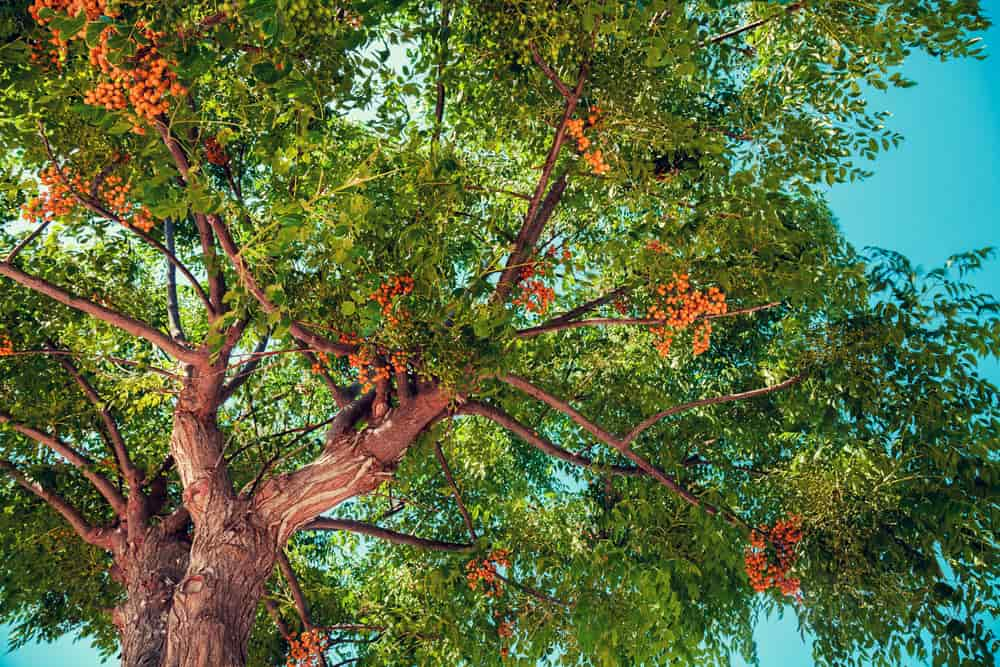For novice and experienced gardeners, fast-growing trees offer many benefits in the Australian landscape.
Whether it’s to provide shade, enhance privacy, or beautify the environment, selecting the right tree is crucial.
Of course, you won’t get a fully-grown tree in your garden in only a year or so — but these species will reach maturity more quickly than other trees.
It’s also worth remembering that planting conditions can vary depending on the specific region of Australia.
Do you need a fast-growing tree in your garden for some colour and foliage ASAP?
Here are some of the best fast-growing trees Australia offers — plus some bonus shrubs, too.
List of Fast-Growing Australian Trees:
- Claret Ash
- Golden Ash
- Japanese Maple
- Tulip Tree
- White Cedar (Melia Azedarach)
- Australian Willow
- Bottle Tree
- Golden Rain Tree
- Illawarra Flame Tree
- Blueberry Ash
- Brush Box
- Lilly Pilly
- Magnolia Grandiflora
- Cider Gum
- Dwarf Flowering Gum
- Lemon-Scented Gum
- Mountain Ash
- Brown Kurrajong
- Lemon-Scented Myrtle
- Macaranga
- Redbud Tree
- Jacaranda
- Tahitian Lime Tree
- Tulipwood
- Moreton Bay Fig
- Grevillea
- Frangipani
- Flooded Gum
- Forest Red Gum
- Quandong Tree
- Bottlebrush
- Dwarf Date Palm
- Tuckeroo
- Wattle
Fast-Growing Deciduous Trees
Fast-growing deciduous trees stand out for their ability to swiftly transform landscapes.
These dynamic trees provide rapid shade and beauty while undergoing a mesmerising transition with seasons.
Claret Ash (Fraxinus angustifolia ‘Raywood’)
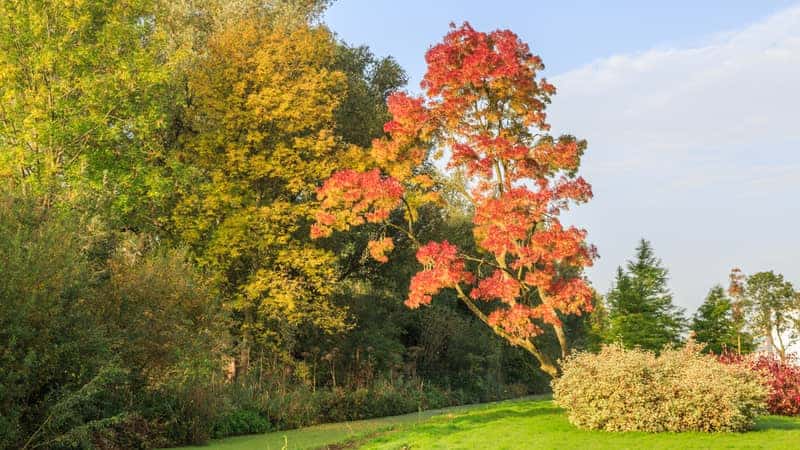
Revered for its captivating burgundy-red autumn foliage, the Claret Ash is a sight to behold in any garden.
During spring, its young green leaves take centre stage.
Plant your Claret Ash somewhere with ample space, as it can spread out.
It requires well-drained soil, and while it can tolerate drier conditions, occasional watering will keep it looking its best.
Golden Ash (Fraxinus excelsior ‘Aurea’)
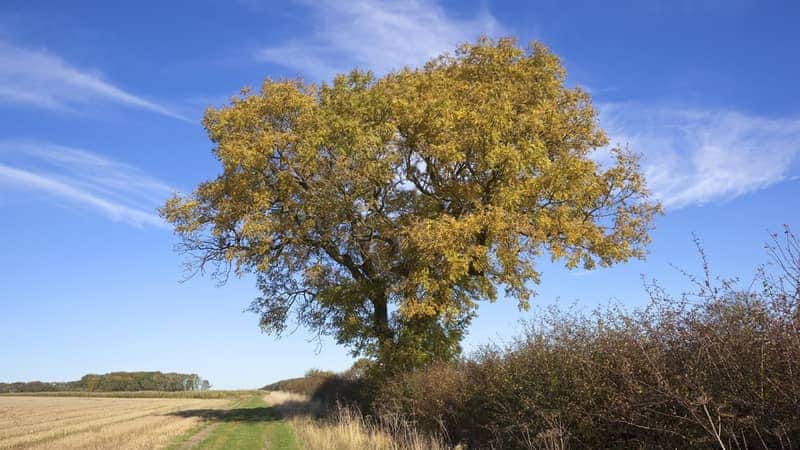
The Golden Ash tree is a sight to marvel at, especially in autumn when its leaves take on a golden hue.
This tree stands out in any landscape and adds a touch of elegance.
The Golden Ash prefers moist, well-drained soil and a sunny location but can tolerate a little shade.
Remember to water it regularly during its early growth stages.
Japanese Maple (Acer palmatum)
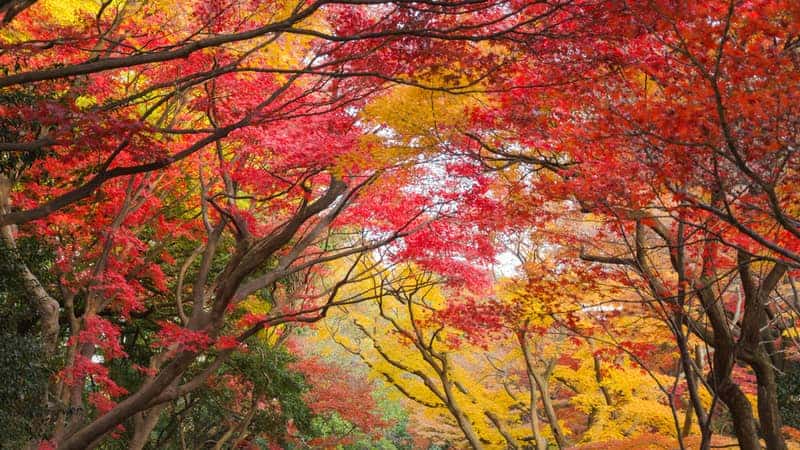
Look no further than the Japanese maple for a glowing autumn colour in your garden.
Few sights are as stunning as its red, orange, and gold foliage on an autumn afternoon.
It’s one of the best ornamental deciduous trees for a garden and provides plenty of shade!
The Japanese maple is a finicky tree since it needs sun for the best colour, but too much will cause the leaves to scorch.
Conversely, too much shade and its foliage won’t be as vivid. “Dappled shade” is the best.
You’ll also need to keep it out of any strong winds!
Tulip Tree (Liriodendron tulipifera)
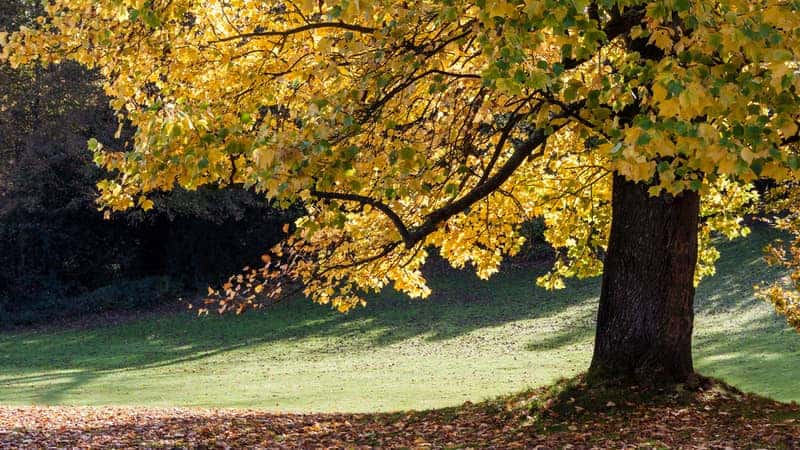
As the name suggests, this tree has tulip-shaped flowers that are a blend of orange, yellow and green.
The leaves turn golden in autumn, giving a double-season display.
The tulip tree likes a sunny to partly shaded position in deep, fertile, well-drained soil.
Regular watering in the early stages is crucial, but mature trees are quite resilient.
White Cedar (Melia azedarach)
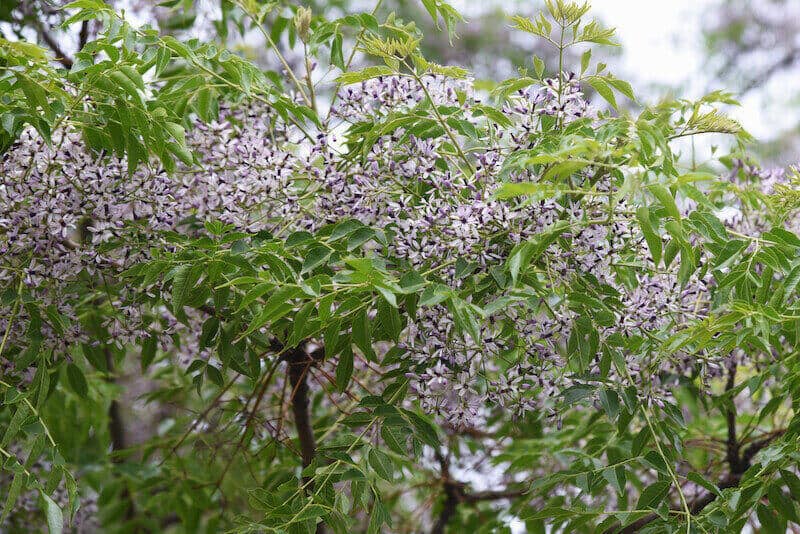
This elegant tree has a rounded canopy with bright green leaves.
Come spring, and it is adorned with fragrant lilac flowers.
Besides being a sight to behold, the White Cedar is also known for its resistance to pests and diseases.
It’s adaptable to a variety of soil types but prefers them well-drained.
Fast-Growing Drought-Tolerant Trees
Drought-tolerant trees are indispensable in Australia’s climate, especially in the drier regions.
Here’s a list of some fast-growing, drought-tolerant trees commonly planted across Australia:
Australian Willow (Geijera parviflora)
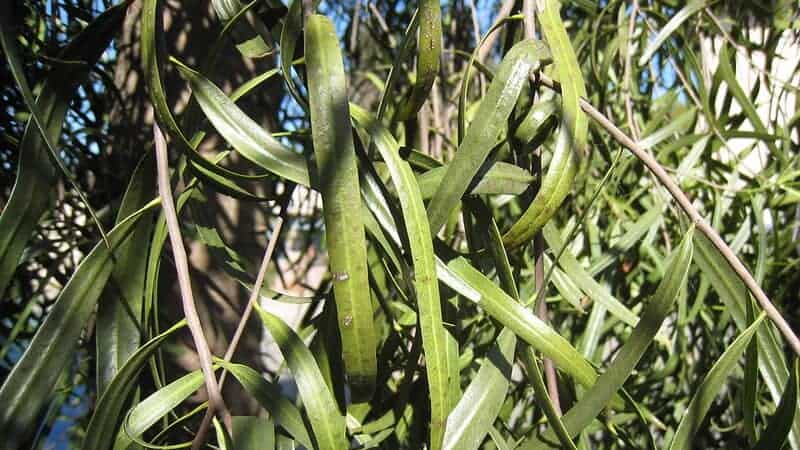
While the Australian Willow isn’t a true willow, its weeping form can easily deceive.
It’s a compact tree with slender, drooping branches that host lance-shaped leaves.
The Australian Willoe can be grown as a stand-alone specimen or pruned into a hedge.
This tree is set to thrive with deep watering sessions in its early stages and a sunny position.
Bottle Tree (Brachychiton rupestris)
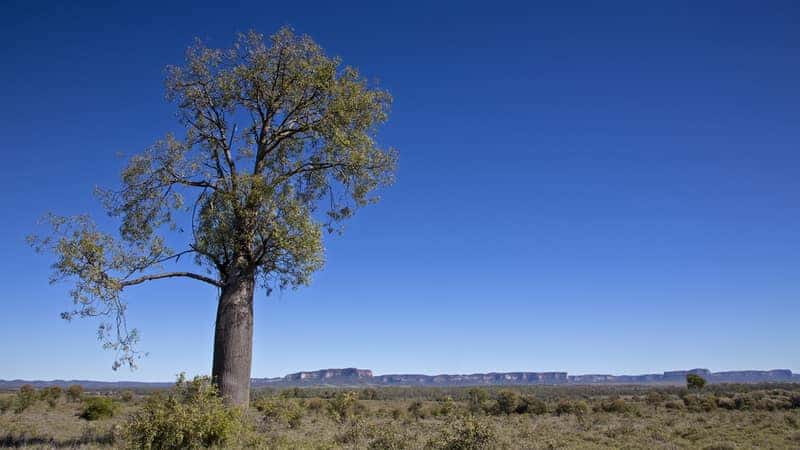
Renowned for its bulbous trunk resembling a bottle, this one is an iconic Australian native tree.
The Bottle Tree can be an interesting focal point, especially when it blooms with star-shaped flowers.
It loves full sun and can thrive in a variety of soil conditions.
Golden Rain Tree (Koelreuteria elegans subsp. formosana)
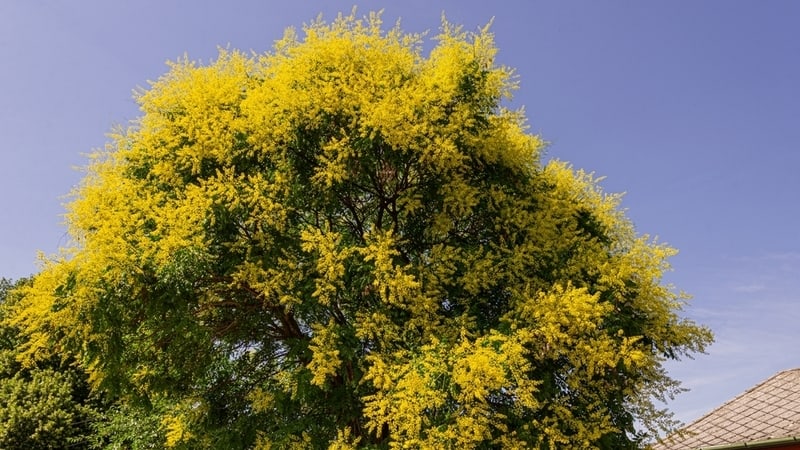
Isn’t it funny that a drought-tolerant tree has “rain” in its name?
This tree brings a rain of golden yellow flowers during its blooming season.
Paired with its bright green foliage, it can light up any garden space.
A lover of sunny spots, the Golden Rain Tree can tolerate various soils, from loam to clay.
Illawarra Flame Tree (Brachychiton acerifolius)
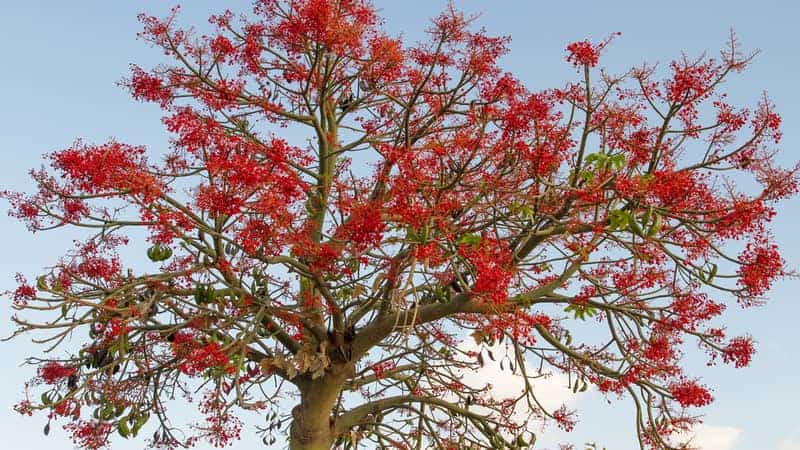
The Illawarra Flame tree is known for its striking red-orange flowers.
It is a medium-sized tree that spreads widely, providing ample shade.
It’s deciduous in drier climates, but it often retains its leaves in more humid settings.
While the Illawarra Flame is drought-tolerant, occasional watering promotes optimal growth.
While these trees are known for their drought-tolerant capabilities, watering them during the initial stages after planting is vital.
Once established, Illawarra Flame trees can typically withstand prolonged dry periods.
Fast-Growing Evergreen Trees
Evergreen trees are popular in Australia, given their ability to provide year-round shade and serve as windbreaks.
When planting evergreen trees in Australia, consider your local climate.
Blueberry Ash (Elaeocarpus reticulatus)
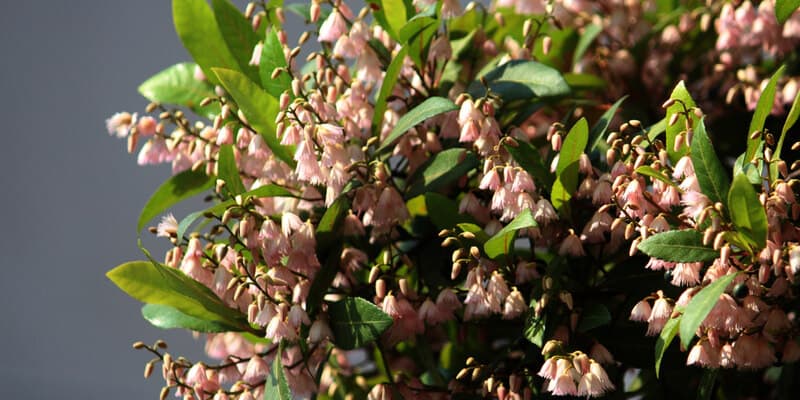
Elaeocarpus reticulatus does indeed have blue berries, although they’re not really meant for human consumption.
The evergreen blueberry ash tree grows blue berries after their white flowers have wilted.
The blueberry ash is a small tree (or tall shrub — it could go either way) and is one of many Australian native plants.
It’s very low maintenance and thrives best in sandy or loamy soils, with full sun to partial shade.
Brush Box (Lophostemon confertus)
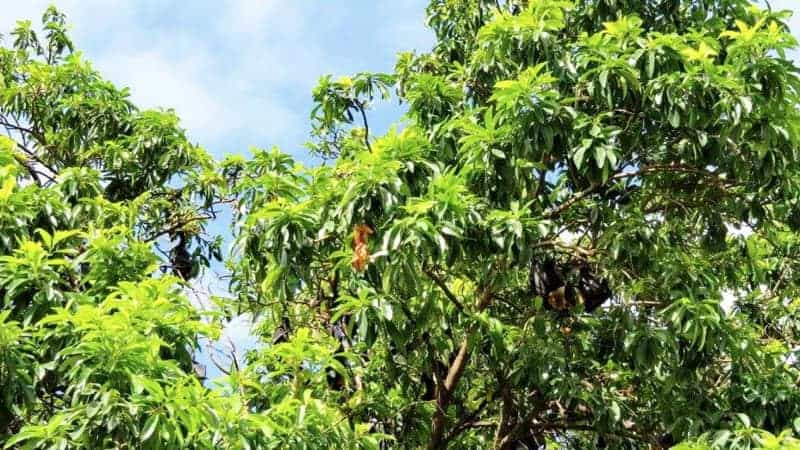
A native to the eastern coast of Australia, the Brush Box is often found in rainforests.
It is widely known for its thick, rough bark and glossy leaves.
This evergreen tree is commonly used in urban settings due to its resilience against pests and diseases.
Lilly Pilly (Syzygium species)
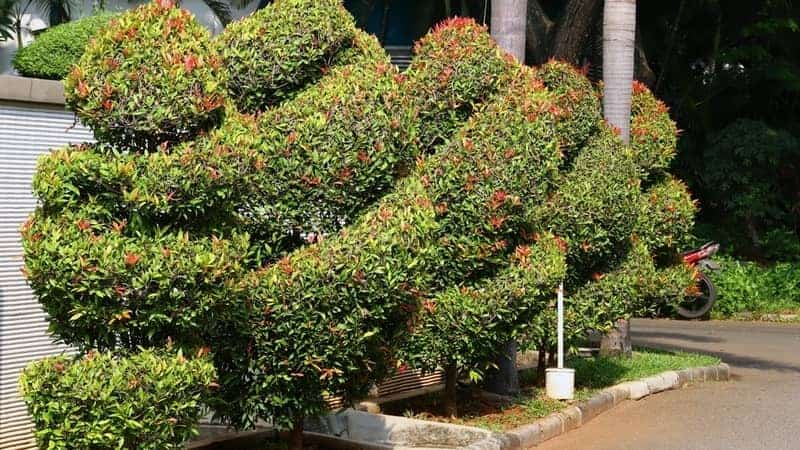
The Lilly Pilly is a versatile Australian native known for its vibrant, colourful berries and glossy green foliage.
Popular as a hedge or screen plant, some Lilly Pilly varieties produce edible fruit.
Magnolia Grandiflora (Magnolia grandiflora)
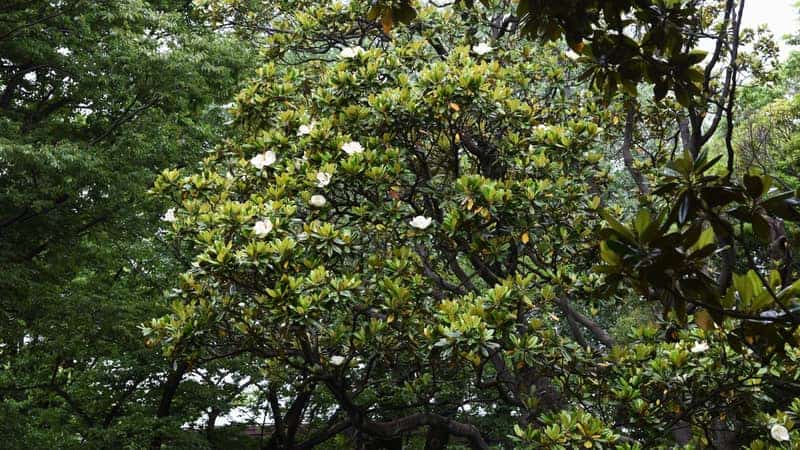
Magnolias are striking trees native to the southeastern United States.
They’re adorned with large, fragrant, creamy-white flowers and dark green, glossy leaves.
The Magnolia tree’s grand blooms are a magnificent sight, which is why they are often used as ornamental trees in various landscapes.
While some Magnolias are deciduous, the Grandiflora variety is evergreen.
Fast-Growing Gum Trees
Gum trees are indigenous to Australia and part of the Myrtle family, with 12 distinct species.
They’re called “gum” because of the thick sap from their trunk whenever the bark breaks.
These trees are fast-growing and have diverse features ranging from their bark to their leaves and flowers.
Cider Gum (Eucalyptus gunnii)
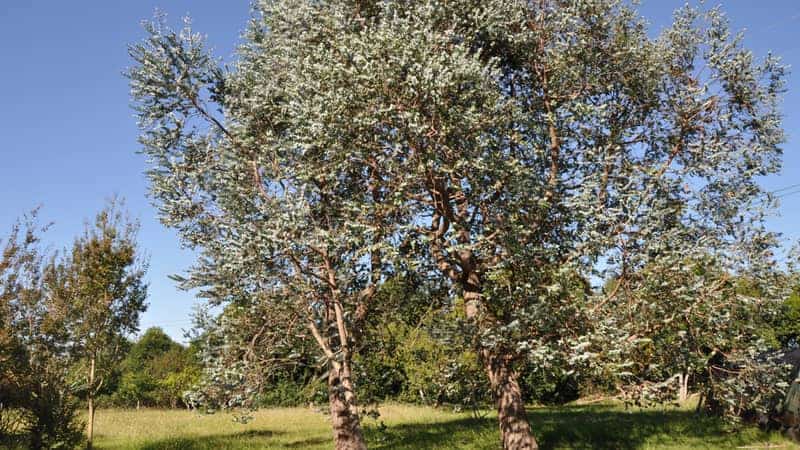
Native to Tasmania, this gum tree is known for its rounded, silver-blue leaves when young, which become more elongated as it matures.
It’s among the hardiest eucalyptus species and is often cultivated for its essential oils and ornamental value.
Dwarf Flowering Gum Tree (Corymibia ficifolia)
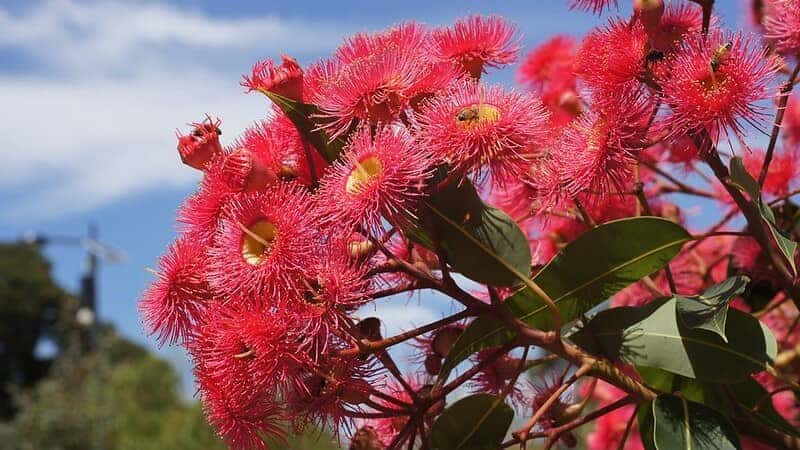
These are Corymibia ficifolia, with different varieties available.
For stunningly coloured flowers on fast-growing trees, check out the ‘Summer Beauty’ (pink) and ‘Summer Red’ (red) varieties.
They flower in summer and can reach around 6 metres tall.
Dwarf gums grow best in full sun, but will tolerate partial shade.
Mature trees are drought-tolerant. Do not grow them in heavy clay soils or other types that retain water easily.
Lemon-Scented Gum Tree (Corymbia citriodora)
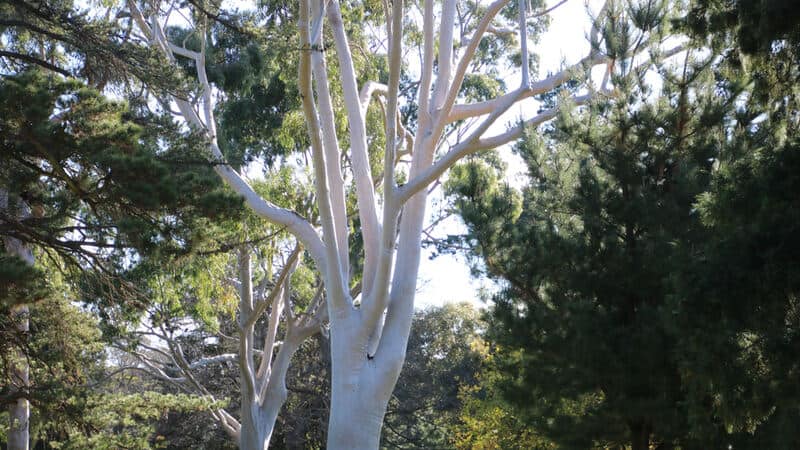
This tree has a distinctive white or pink trunk with alluring lemon-scented leaves.
This gum variety can grow up to 35 metres tall, although it will be smaller in cultivation.
However, its strong roots mean you should plant it away from structures.
This tree likes full sun and will thrive in well-drained soil. It does not tolerate frost while it’s young.
The lemon-scented gum is one of your best options for fast-growing garden trees — especially for large gardens.
Its scented white blossoms produce a unique fragrance, making it an attractive ornamental tree for your yard.
Mountain Ash (Eucalyptus regnans)
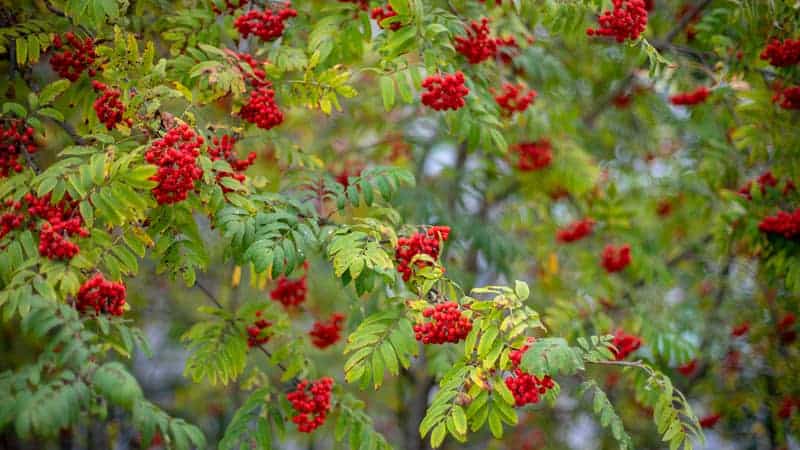
Holding the title of the world’s tallest flowering plant, the Mountain Ash towers over other trees, particularly in the cool temperate rainforests of Tasmania and Victoria.
It has a straight, grey trunk and produces white flowers.
Fast-Growing Rainforest Trees
Australia’s rainforests are home to many unique and beautiful tree species.
Many of these trees can grow rapidly under the right conditions.
Let’s look at some popular fast-growing rainforest trees:
Brown Kurrajong (Commersonia bartramia)
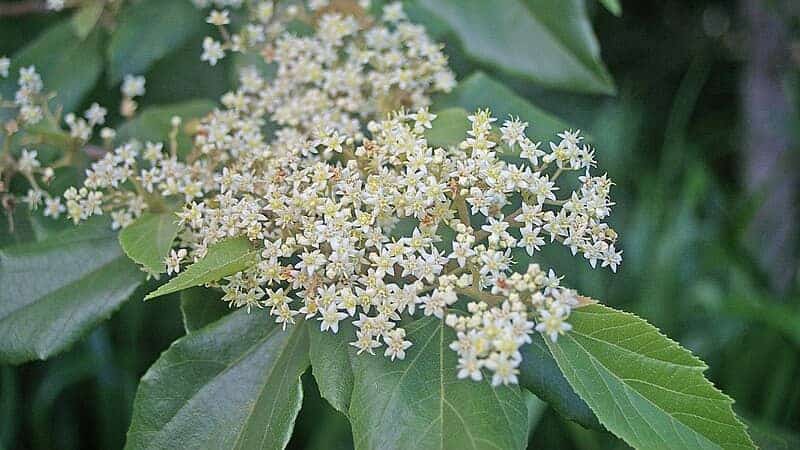
This medium-sized tree showcases large, heart-shaped leaves.
In summer, the Kurrajong tree presents white to pale yellow flowers.
It can thrive in both sun and partial shade.
While it can tolerate dry spells, regular watering in its growing phase aids in better growth.
Lemon-Scented myrtle (Backhousia citriodora)

Backhousia citriodora, or the lemon-scented myrtle, is a gorgeous tree with clusters of white-yellow flowers.
When it rains, or you crush the leaves, the tree releases a heady citrus aroma.
In gardens, it can reach up to 8 metres in height.
Plant your lemon-scented myrtle in slightly acidic, well-drained soil. It likes sunny spots but can tolerate partial shade.
They’re better propagated from cuttings or seedlings, so check your local nursery.
Macaranga (Macaranga tanarius)
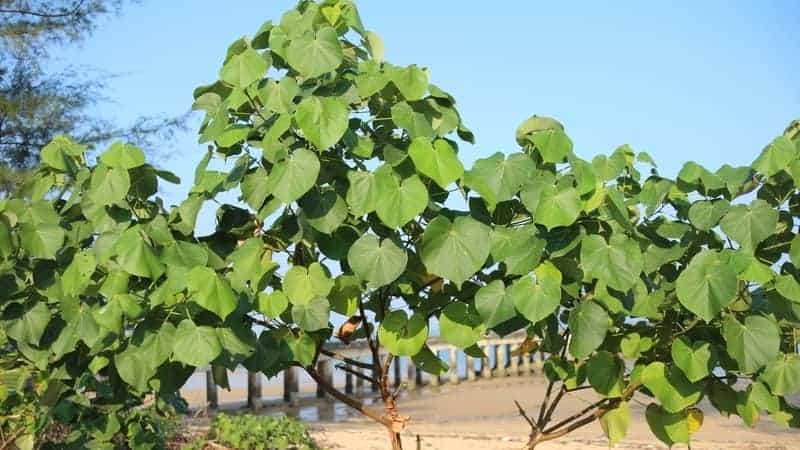
Often called the “Nasturtium Tree” for its large, round leaves, the Macaranga stands out in any garden setting.
Small yellow flowers are its signature, attracting various fauna.
This rainforest tree thrives in rich, well-draining soil and requires consistent moisture.
Fast-Growing Shade Trees
Shade trees are essential in Australia, especially in regions experiencing scorching summers.
They not only provide much-needed shade but also add beauty and habitat for local fauna.
When planting shade trees, it’s essential to consider their mature size to ensure they have enough space to grow and spread without causing disruptions.
Redbud Tree (Cercis canadensis ‘Forest Pansy’)

Also known as the “Purple Redbud” or “Eastern Redbud”, this breathtaking tree features purple-tinged green leaves through summer.
They become gold and peach in autumn before falling to reveal a sleek silhouette.
Then you can welcome spring with a burst of purple-pink flowers.
You can grow a Forest Pansy in most soils, but it won’t tolerate prolonged drought or wetness.
At maturity, it will reach 5 metres tall and 5 metres wide.
Jacaranda Tree (Jacaranda mimosifolia)
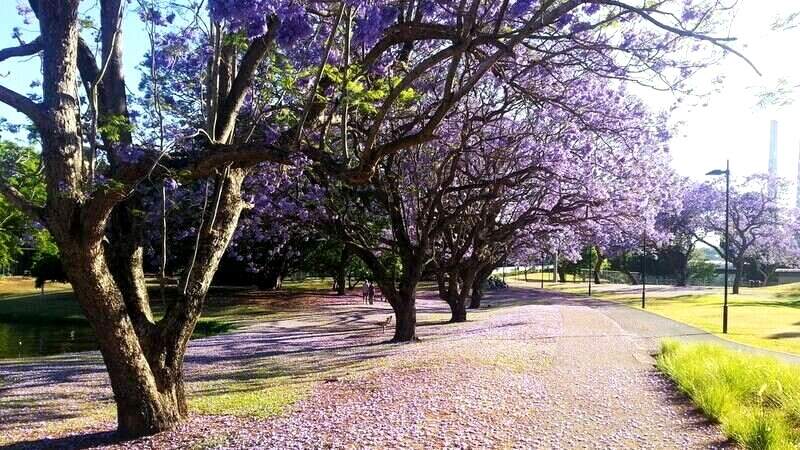
The Jacaranda is an iconic Australian flowering tree, especially when it floods the surroundings with a sea of purple blossoms in late spring to early summer.
Plant your Jacaranda in a sunny spot with well-drained soil.
Water well during its early years, and you’ll soon have a shade-providing beauty in your garden.
Tahitian Lime Tree (Citrus latifolia)
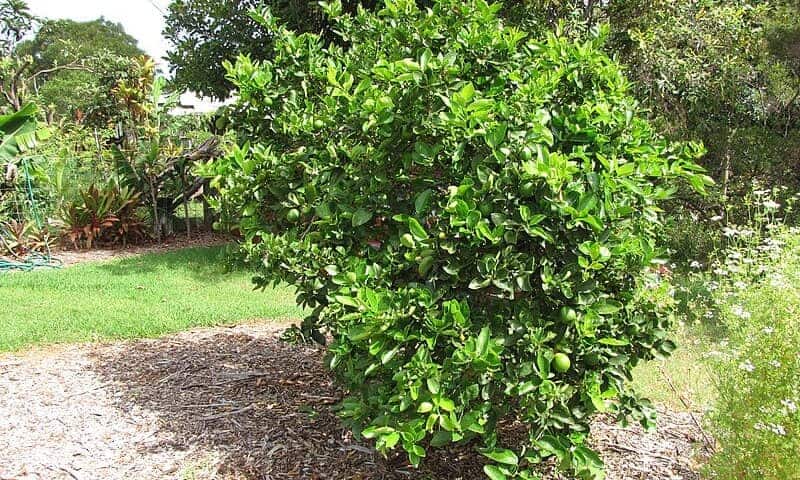
This citrus fruit tree prefers tropical climates — so plant it somewhere warm and sunny.
You’ll love it for its glossy, deep green leaves that contrast the fragrant white flowers – and of course, its delicious green fruits.
Tahitian lime bears fruit year-round, so you’ll have a constant supply of refreshing citrus whenever you need some.
Tahitian limes need regular watering while they’re establishing, but mature trees can take drought.
Ensure your tree is in well-drained soil – this plant doesn’t like wet feet!
Tulipwood (Harpullia pendula)

A smaller Australian native tree, the Tulipwood offers attractive, glossy green leaves and yellowish-green flowers.
It loves well-drained soil and can flourish under full sun or partial shade.
It’s drought-resistant once established but appreciates a drink during extended dry periods.
Moreton Bay Fig (Ficus macrophylla)
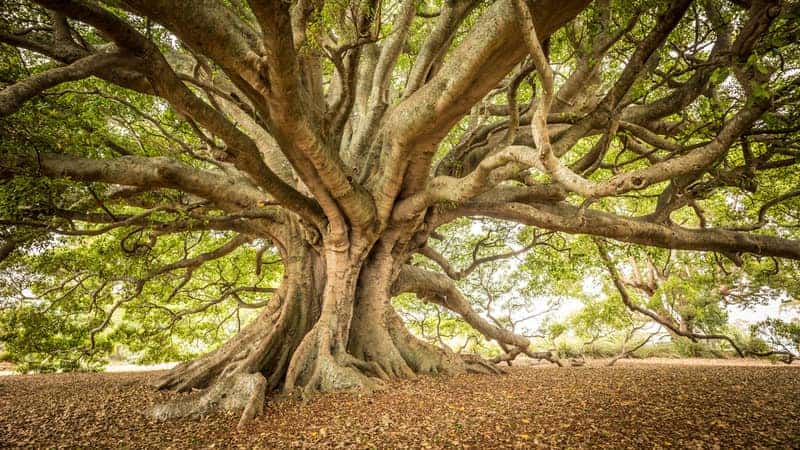
This majestic tree can grow large and provides a wide, shady canopy.
Its signature is its aerial roots that eventually reach the ground, thickening into woody trunks.
Moreton Bay Fig trees need ample space and well-draining soil.
Regular watering, especially in its formative years, ensures healthy growth.
Fast-Growing Trees for Privacy
When planting trees for privacy, consider the spacing between each plant.
While you might be tempted to plant them closely for immediate privacy, remember they’ll grow and spread.
Give them ample room to grow to their mature size without becoming crowded.
Trees that provide privacy are often sought-after for their ability to quickly establish a natural screen, shielding homes from prying eyes and blocking out noise.
Clumping Bamboo (Bambusa species)
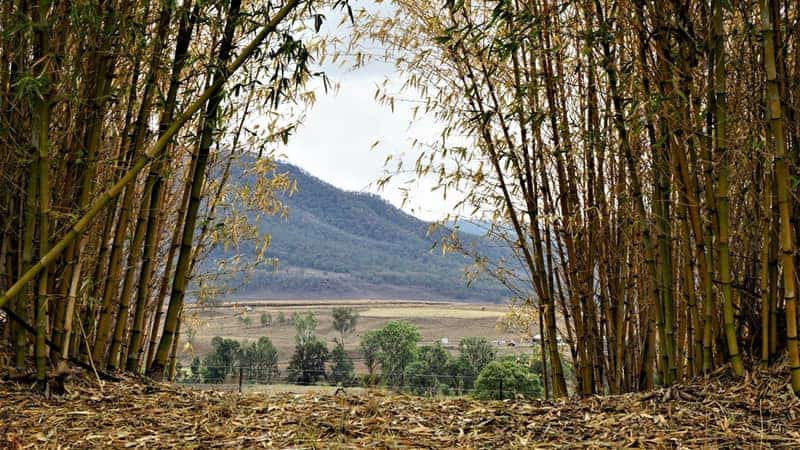
Unlike its running counterparts, clumping bamboos grow in tight clusters and are less invasive.
They are popular as screens, hedges, or ornamental plants in gardens, adding an Asian flair to landscapes.
Grevilleas
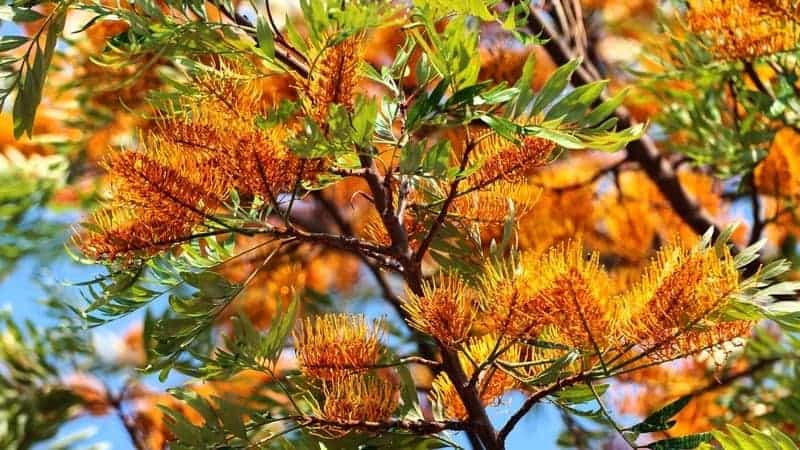
These native shrubs are also known as spider flowers; if you’ve seen them, you’ll know why.
Just know that if you grow a grevillea feature tree, you need to be ready for some busy-buzzy and feathery friends dropping by for a sip!
Grevilleas love the sun but need shelter from strong winds. Try to grow them in a raised garden bed so the soil drains freely.
Frost and drought tolerance will vary between species, so check with your local nursery beforehand.
Some varieties to grow include the Grevillea ‘Superb’, ‘Elegance’, ‘Moonlight’, and ‘Peaches and Cream’.
Frangipani Trees
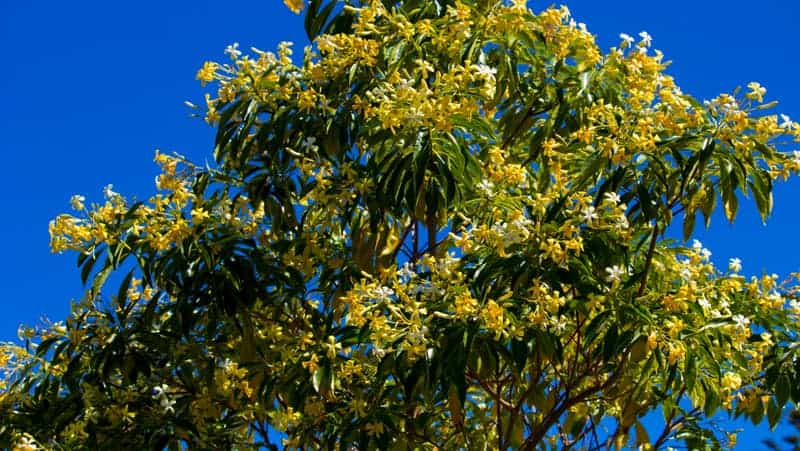
These are denser than grevilleas and can grow 6–8 metres high.
Native frangipanis have shiny green leaves and creamy yellow flowers.
This fast-growing tree can thrive in sun to partial shade — but keep it out of the afternoon light for best growth.
You can plant frangipanis anywhere in your garden, even near structures like pools!
They like sandy soil, but can grow anywhere that’s free-draining.
They’re good with the salty air of a coastal area but don’t like frost.
Lilly Pilly Pinnacle (Syzygium australe cultivar)
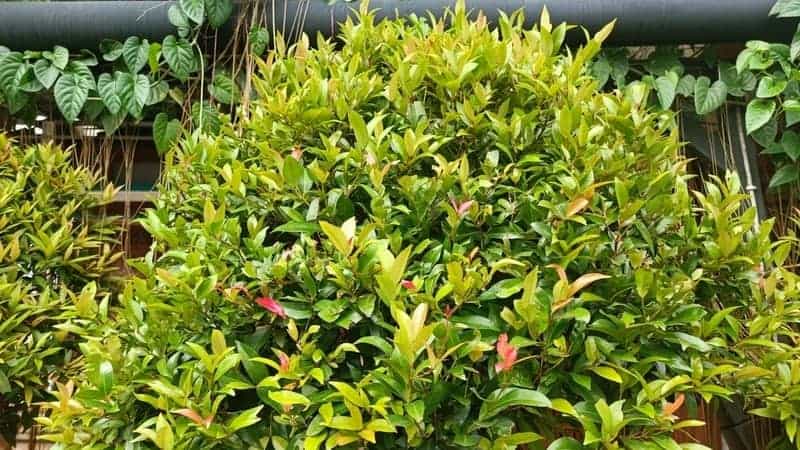
A versatile native Australian tree often used for hedges and privacy screens.
Its dense growth, colourful new foliage, and edible berries offer aesthetics and functionality.
Sweet Viburnum (Viburnum odoratissimum)
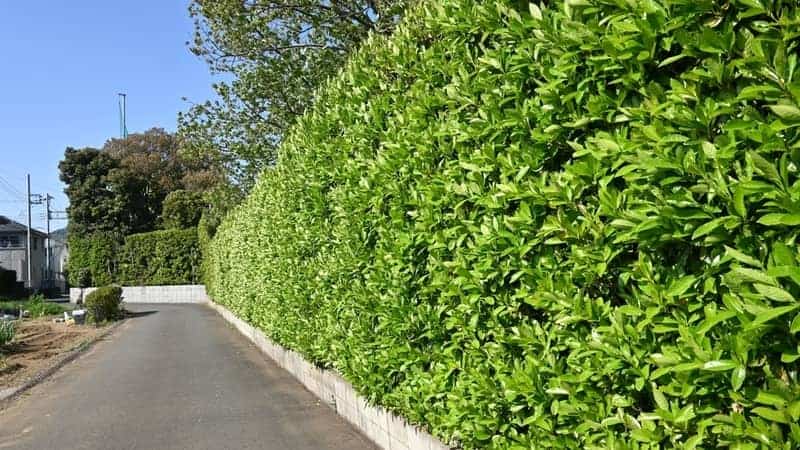
A popular choice for hedges and screens, sweet viburnum offers dense growth and can reach up to 4 metres in height.
Its large, glossy deep green leaves can create an effective privacy barrier.
It’s native to Asia and is known for its fast growth and adaptability.
Large Fast-Growing Trees
When planting large trees, it’s vital to consider their eventual size, both in height and canopy spread, to ensure they’re positioned well away from structures and utilities.
These large, fast-growing garden trees have extensive root systems and need ample space to grow without disturbances.
Flooded Gum (Eucalyptus grandis)

Another towering eucalypt, this tall, straight tree is found along the eastern coast of Australia.
The Flooded Gum can reach heights of up to 55 metres in ideal conditions.
With smooth bark that sheds in large patches or flakes, it’s often used for timber.
Forest Red Gum (Eucalyptus tereticornis)
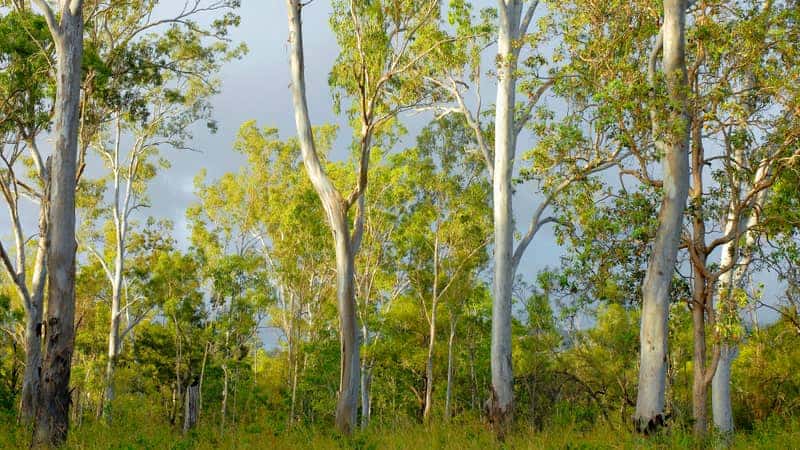
A common sight in eastern Australia, the Forest Red Gum tree is recognised for its smooth, multi-coloured bark and hardy nature.
It thrives in various soils and conditions, making it a favourite for timber and as a shade tree.
This tree can swiftly grow to around 50 metres.
It features rough bark, and its wood has been traditionally used for heavy construction.
Lilly Pilly Waterhousea floribunda (aka Syzygium floribundum)
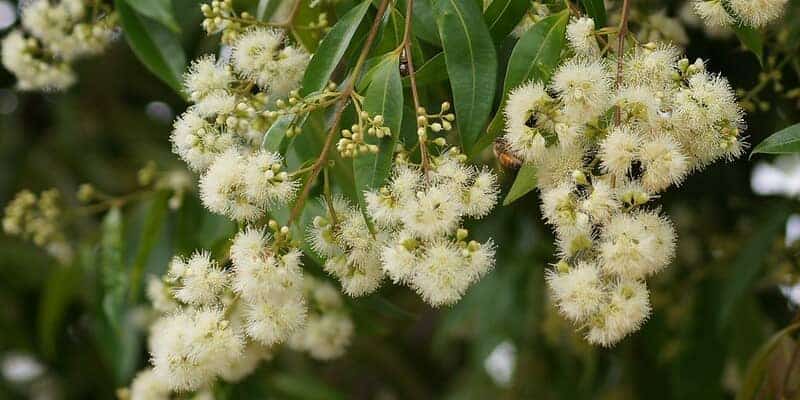
An excellent choice for a hedge or a standalone feature, the Lilly Pilly Waterhousea floribunda has long, glossy green leaves and soft, fluffy white flowers.
The flowers are followed by pinkish fruits.
This evergreen prefers moist, well-draining soil and benefits from regular watering in its early years.
Quandong Tree (Elaeocarpus eumundii)
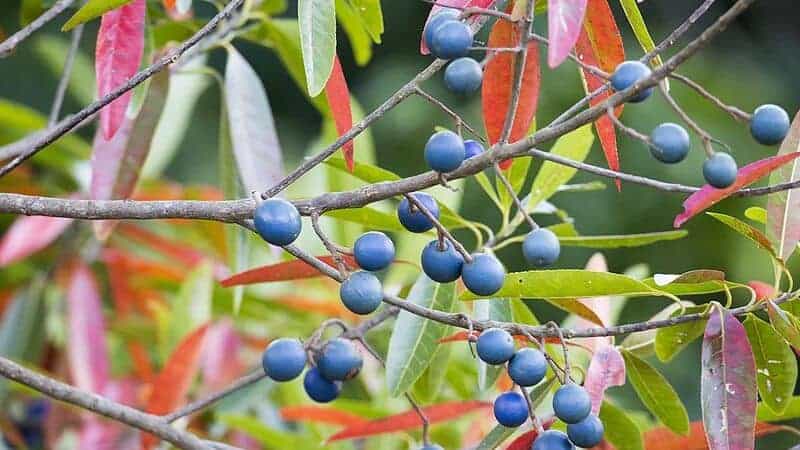
An Australian native, this tree produces stunning blue fruits that contrast beautifully with its glossy green leaves.
Growing up to 12 metres, Quandong trees are ideal for medium-to-large gardens.
Plant them in early spring in a well-draining, sunny location.
Small Fast-Growing Trees
While large trees can make a statement, small trees can fit more comfortably into various landscape settings, especially urban gardens or smaller plots.
When planting small trees in Australian conditions, it’s essential to consider their eventual size and potential spread.
Even if they’re smaller in stature, they’ll still need room to grow and flourish.
Bottlebrush (Callistemon species)

Iconic for their vibrant, brush-like flowers, which resemble a bottle brush, these Australian natives attract various birds and insects.
Bottlebrush trees are hardy, adaptable, and come in a range of sizes and colours.
Dwarf Date Palm (Phoenix roebelenii)
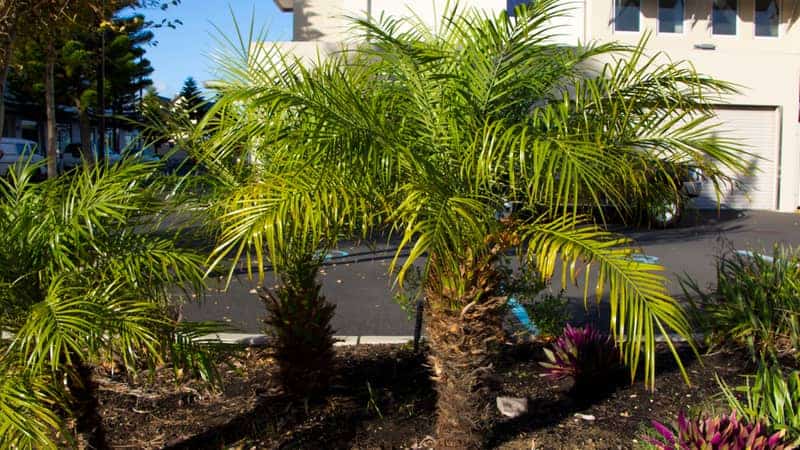
This petite palm tree, native to Southeast Asia, is well-suited for indoor and outdoor cultivation.
Perfect for smaller gardens, this palm typically reaches 2–3 metres.
Its feather-like fronds and slender trunk make it popular for ornamental purposes.
It offers a tropical feel with its slender trunk and feathery fronds.
Tuckeroo (Cupaniopsis anacardioides)
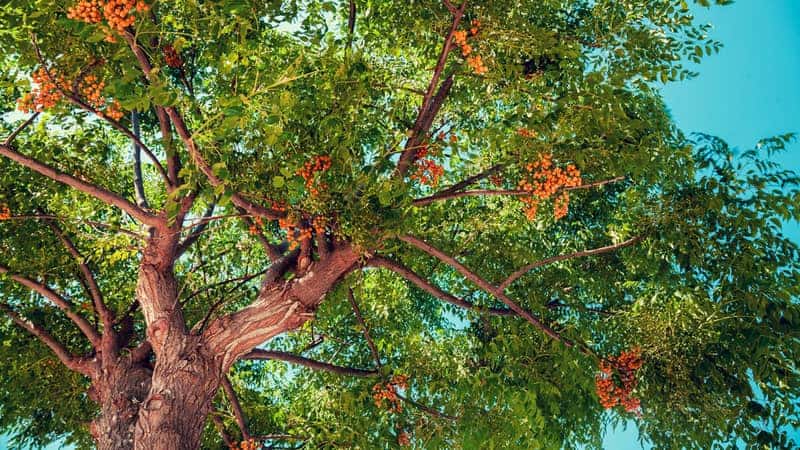
A hardy native, the Tuckeroo tree can grow to around 8 metres.
It offers glossy leaves, fragrant flowers, and ornamental yellow-orange fruits.
Another interesting feature is that it’s resilient to salt spray, making it an excellent choice for seaside plantings.
Wattle (Acacia species)
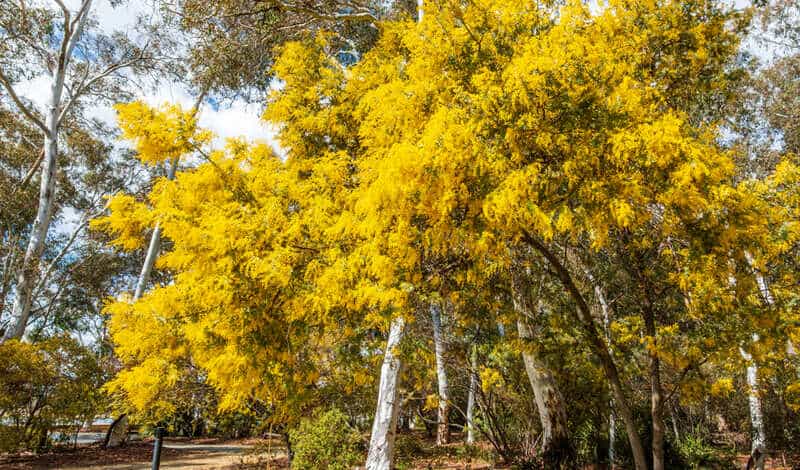
Symbolic of Australia, wattle trees have a distinctive presence with golden yellow flowers.
There are over 1,200 species of Acacia, making them a diverse group ranging from shrubs to tall trees.
For instance, the Cootamundra Wattle (Acacia baileyana) grows up to 5 metres and flaunts silvery-blue leaves with bright yellow flowers.
Weeping Lilly Pilly (Waterhousia floribunda)
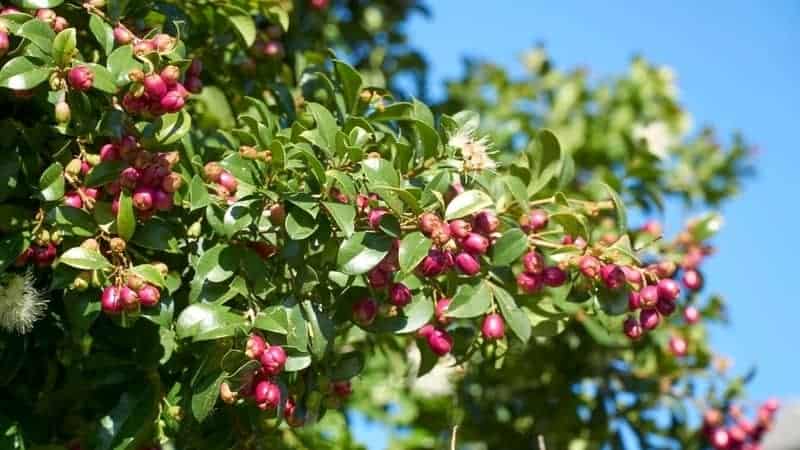
A graceful, evergreen tree, the Weeping Lilly Pilly is known for its drooping branches and glossy, dark green leaves.
This evergreen tree features lush, “weeping” foliage and grows up to 7–8 metres.
It produces clusters of white flowers followed by pink berries, making it a favourite for ornamental planting and hedging.
Caring for Fast-Growing Trees
Any seasoned gardener knows that rapid growth often requires more care.
Most trees will need regular watering while establishing themselves so the root ball doesn’t dry out.
Mature trees need less frequent watering — let the moisture sink in deep, with more time in between.
Keep your fast-growing tree in well-drained soil (although, make sure it still retains some moisture!).
If you’re growing your tree as a privacy hedge, prune it regularly for uniform growth.
Note that because these trees mature earlier, they also have shorter lifespans.
Once you’ve planted your seed or seedling — that’ll depend on the type of tree — simply sit back and wait (im)patiently for it to grow!
Then soon enough, you’ll have a beautiful feature tree for your garden.

